Do You Know What It Means To Miss New Orleans (en una película)
Billie Holiday (voz), Louis Armstrong (corneta), Barney Biggard (clarinete), Kid Ory (trombón), Charlie Beal (piano), Bud Scott (guitarra), Red Callender (contrabajo) y Zutty Singleton (batería). Escena de la película New Orleans (1947).
En 1943 Louis Armstrong participó en la película musical Cabin in the Sky dirigida por Vincente Minnelli basada en el musical de Broadway de 1940 del mismo nombre con un reparto exclusivamente negro. Durante la Segunda Guerra Mundial tocó para las tropas a través del Servicio de Radio de las Fuerzas Armadas y grabó en «V-Discs» distribuidos al personal militar. En 1947 grabó con su big band la banda sonora de la película romántica musical New Orleans con Billie Holiday como doncella cantante y él mismo como director de banda interpretando a una pareja que se enamora.
In 1943 Louis Armstrong participated in the musical film Cabin in the Sky directed by Vincente Minnelli based on the 1940 Broadway musical of the same name with an all-black cast. During World War II he played for the troops over the Armed Forces Radio Service and recorded on “V-Discs” distributed to military personnel. In 1947 he recorded with his big band the soundtrack of the musical romance movie New Orleans with Billie Holiday as a singing maid and himself as a bandleader portraying a couple falling in love.
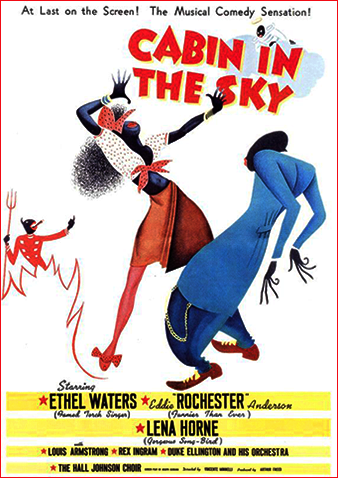
Cartel de Cabin in the Sky
Fuente
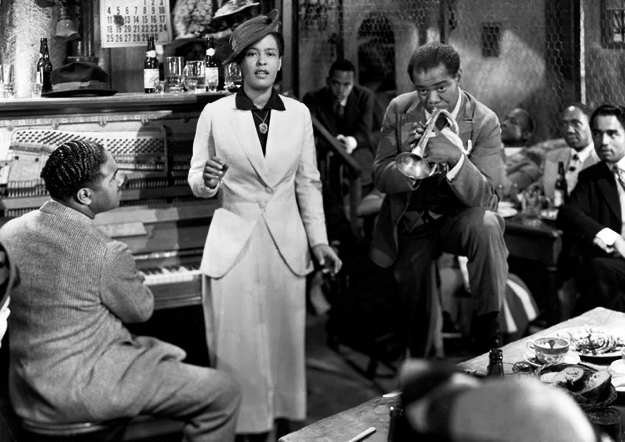
Billie Holiday y Louis Armstrong en la película New Orleans
Fuente
En los años cuarenta las big bands entraron en decadencia debido al cambio en los gustos del público. Muchas salas de baile cerraron y con el auge del bebop, el rhythm and blues y la televisión, el swing dejó de estar de moda. Por lo tanto, Armstrong no pudo seguir manteniendo su big band de dieciséis miembros. Sin embargo, el renacimiento del jazz tradicional de los años veinte le permitió volver al estilo musical de pequeños grupos de su juventud. Llamó a su nuevo conjunto «Louis Armstrong and his All Stars», reunió a Barney Bigard al clarinete, Jack Teagarden al trombón, Earl Hines al piano, Arvell Shaw al contrabajo y Big Sid Catlett a la batería, y se estrenaron en agosto de 1947 en el club Billy Berg de Los Ángeles. A lo largo de su existencia pertenecieron a la banda la cantante Velma Middleton, los clarinetistas Joe Muranyi, Eddie Shu, Joe Darensbourg y Edmond Hall, los trombonistas Tyree Glenn y Trummy Young, los pianistas Marty Napoleon y Billy Kyle, los contrabajistas Mort Herbert y Arvell Shaw, y los baterías Danny Barcelona, Barrett Deems, Cozy Cole y Sid Catlett.
In the 1940s big bands went into decline due to changing public tastes. Many dance halls closed down and with the rise of bebop, rhythm and blues and television, swing was no longer in fashion. Thus, Armstrong was unable to continue maintaining his 16-piece orchestra. However, a revival of the traditional jazz of the 1920s made it possible for him to return to the small-group musical style of his youth. He called his new ensemble “Louis Armstrong and his All Stars”, gathered Barney Bigard on clarinet, Jack Teagarden on trombone, Earl Hines on piano, Arvell Shaw on double bass and Big Sid Catlett on drums, and opened in August 1947 at the Billy Berg’s club in Los Angeles. Throughout its existence, the band included singer Velma Middleton, clarinetists Joe Muranyi, Eddie Shu, Joe Darensbourg and Edmond Hall, trombonists Tyree Glenn and Trummy Young, pianists Marty Napoleon and Billy Kyle, double bassists Mort Herbert and Arvell Shaw, and drummers Danny Barcelona, Barrett Deems, Cozy Cole, and Sid Catlett.
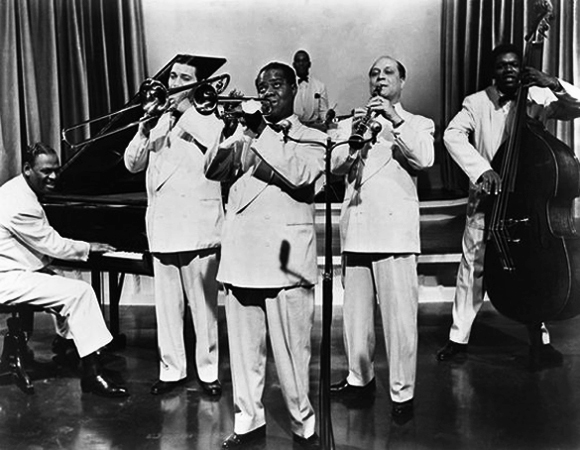
Louis Armstrong y sus All Stars
Fuente
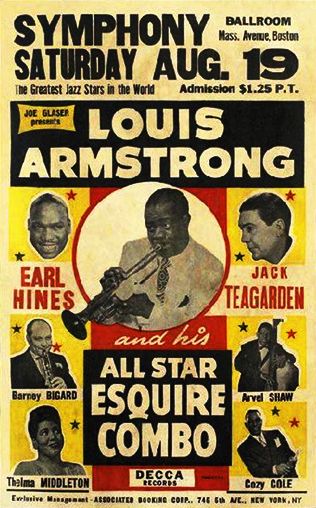
Cartel de una actuación en el salón de baile Ballroom de Boston
Fuente
En 1948 Armstrong se embarcó en una gira europea y a partir de entonces realizó giras periódicas por todo el mundo. Mientras estuvo en Francia tocó con sus All Stars en el primer festival de jazz de relevancia internacional, celebrado en Niza, donde escuchó a la vocalista, bailarina y actriz Suzy Delair cantar «C’est si bon». Le gustó tanto la canción que dos años más tarde grabó su propia versión en inglés con letra de Jerry Seelen en Nueva York con Sy Oliver y su orquesta. Cuando salió a la venta se convirtió en un éxito mundial y desde entonces fue interpretada por los mejores cantantes.
In 1948 Armstrong embarked on an European tour and thereafter toured regularly around the world. While in France he played with his All Stars in the first jazz festival of international significance, held in Nice, where he heard vocalist, dancer and actress Suzy Delair sing “C’est Si Bon”. He liked the song so much that two years later he recorded his own English version with lyrics by Jerry Seelen in New York backed up by Sy Oliver and his Orchestra; please, find it below. When it was released became a worldwide success and from then on was performed by the best singers.
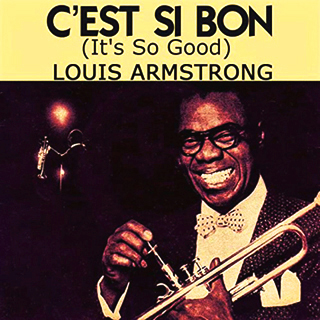
Cubierta de «C’est Si Bon»
Fuente
Translated with the help of DeepL
https://www.youtube.com/watch?v=m4jU8IQK5b0
Fuente

Do You Know What It Means To Miss New Orleans (en directo)
Extraído de «The Great Chicago Concert» (1956).
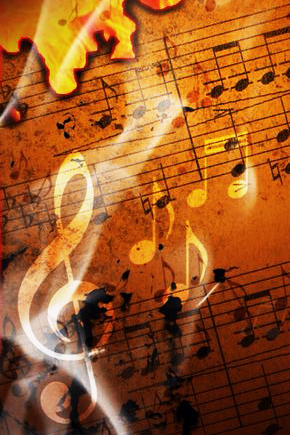
Fuente
https://www.youtube.com/watch?v=YS5MNK0_X_Q
Fuente

C’est Si Bon (original version)
Louis Armstrong con Sy Oliver and his Orchestra: Sy Oliver (director, arreglista), Louis Armstrong (trompeta, voz), Milt Yaner (saxo alto, clarinete), George Dorsey (saxo alto), Freddy Williams y Al Klink (saxo tenor, clarinete), Cutty Cutshall (trombón), Billy Kyle (piano), Sandy Block (contrabajo) y Bunny Shawker (batería) (1950).
https://www.youtube.com/watch?v=Mg5eTKnSGhI
Fuente

C’est Si Bon (en la televisión)
1962.
https://www.youtube.com/watch?v=OFCS7kZwxug
Fuente










